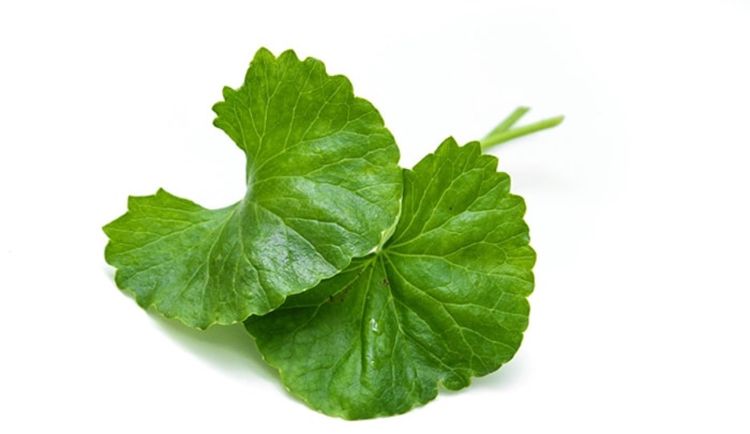BACKGROUND
Ingredient Type: Botanical, Extract, Herb
Also Known As: Centella asiatica, Asian coinleaf, Asiatic pennywort, Centella, Indian penny-wort, Sheep-rot, Spadeleaf, Thankuni

Gotu kola is an aquatic perennial plant that is a member of the parsley family. It is native to India, Madagascar, Sri Lanka, Africa, Australia, China, and Indonesia (1). It is used widely in Ayurveda (where it is revered as a spiritually uplifting herb), by traditional African herbalists, and in Traditional Chinese Medicine. Gotu kola was also used in Europa and France during the 1700s and later was accepted as a drug in 1880s (1).
Gotu kola is used traditionally and in health supplements today to promote mental clarity and relaxation and to support blood circulation and tissue strength.
TRADITIONAL USES
Gotu kola extract is used for fatigue, anxiety, depression, improving memory and cognitive function, Alzheimer’s disease and epilepsy. It is also used for venous insufficiency including varicose veins, deep vein thrombosis, diabetic microangiopathy, and atherosclerosis (2).
WHAT DOES SCIENCE TELL US?
- Studies show gotu kola used orally for 4-8 weeks seem to improve measures of circulation and decrease symptoms such as edema in patients with venous insufficiency (3,4,5).
- The triterpenoid saponins (e.g. asiaticoside, madecassoside) seem to increase wound healing and decrease venous pressure in venous insufficiency (6).
- The terpenoid extract of gotu kola seems to improve connective tissue remodeling by increasing fibroblast activity, stimulating collagen synthesis, increasing epithelial turnover over, and decreasing capillary permeability (7).
- The terpenoid extract might help stabilize arterial plaques by increasing collagen within plaques. Plaques with low collagen content are structurally weak and are associated with an increased risk of rupture and embolism (8).
SAFETY
Gotu kola is generally considered to be safe when used topically or orally and appropriately. Gotu kola has been used safely orally in trials lasting up to 12 months (9).
There is limited and unsubstantiated evidence that Centella asiatica may cause hepatoxicity (10).
Interactions:
Moderate
- CNS Depressants, Hepatotoxic Drugs
Theoretical
- Concomitant use with other potentially hepatotoxic products might increase the risk of developing liver damage. Some of these products include androstenedione, chaparral, comfrey, DHEA, germander, niacin, pennyroyal oil, red yeast, and others (11).
- Concomitant use with herbs that have sedative properties might enhance therapeutic and adverse effects. Some of these supplements include 5-HTP, calamus, California poppy, catnip, hops, Jamaican dogwood, kava, St. John’s wort, skullcap, valerian, yerba mansa, and others (12).
Side-Effects:
Orally, Gotu kola appears to be well tolerated. Gastric irritation and nausea have been the most common side effects reported in clinical research. Rarely, Gotu kola may cause hepatotoxicity. It is not clear, however, if Gotu kola-induced hepatotoxicity results from hepatotoxic contaminants. It is also unclear if the effect is dose-related. A single case of the nighttime eating syndrome has been associated with Gotu kola use. Topically, Gotu kola may cause allergic contact dermatitis and eczema (2).
REFERENCES
- Chandrika UG, Prasad kumarab PA. Gotu Kola (Centella asiatica): Nutritional Properties and Plausible Health Benefits. Adv Food Nutr Res. 2015;76:125-57
- https://naturalmedicines.com
- Marastoni, F., Baldo, A., Redaelli, G., and Ghiringhelli, L. [Centella asiatica extract in venous pathology of the lower limbs and its evaluation as compared with tribenoside]. Minerva Cardioangiol. 1982;30(4):201-207.
- Cesarone, M. R., Laurora, G., De Sanctis, M. T., Incandela, L., Grimaldi, R., Marelli, C., and Belcaro, G. [The microcirculatory activity of Centella asiatica in venous insufficiency. A double-blind study]. Minerva Cardioangiol. 1994;42(6):299-304
- Belcaro G, Laurora G, Cesarone MR, and et al. Efficacy of Centellase (R) in the treatment of venous hypertension evaluated by a combined microcirculatory model. Curr Ther Res 1989;46(6):1015-1026.
- Belcaro GV, Rulo A, Grimaldi R. Capillary filtration and ankle edema in patients with venous hypertension treated with TTFCA. Angiology 1990;41:12-8
- Cesarone MR, Incandela L, De Sanctis MT, et al. Evaluation of treatment of diabetic microangiopathy with total triterpenic fraction of Centella asiatica: a clinical prospective randomized trial with a microcirculatory model. Angiology 2001;52 Suppl 2:S49-54
- Incandela L, Belcaro G, Cesarone MR, et al. Treatment of diabetic microangiopathy and edema with total triterpenic fraction of Centella asiatica: a prospective, placebo-controlled randomized study. Angiology 2001;52 Suppl 2:S27-31.
- Bradwejn J, Zhou Y, Koszycki D, Shlik J. A double-blind, placebo-controlled study on the effects of Gotu Kola (Centella asiatica) on acoustic startle response in healthy subjects. J Clin Psychopharmacol 2000;20:680-4
- Rev Esp Enferm Dig. 2005 Feb;97(2):115-24.Hepatotoxicity associated with the ingestion of Centella asiatica.[Article in English, Spanish]Jorge OA1, Jorge AD.
- Jorge OA, Jorge AD. Hepatotoxicity associated with the ingestion of Centella asiatica. Rev Esp Enferm Dig 2005;97:115-24
- Brinkhaus B, Lindner M, Schuppan D, Hahn EG. Chemical, pharmacological and clinical profile of the east Asian medical plant Centella asiatica. Phytomedicine 2000;7:427-48
See the Penn State Hershey Health Information Library entry for gotu kola, the WebMD entry for gotu kola, the Examine.com entry for Centella asiatica, the RXList entry for gotu kola, this Europena Medicines Agency monograph on Centella asiatica, or the Michigan Medicine Health Library entry for gotu kola for more information.




